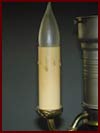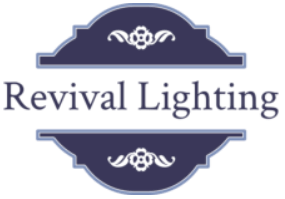Glossary of Lighting
BACKPLATE:
The part of a wall sconce that affixes to the wall (or electrical box) and covers the junctions within.
The part of a wall sconce that affixes to the wall (or electrical box) and covers the junctions within.
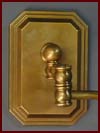
BOWLS:
With the dramatic increase in light output of the “new”, ductile tungsten bulb brought out in 1911, fixture designs opened up. Indirect lighting, which uses light reflected off the ceiling, helped moderate shadows and offered a more gentle room illumination. An offshoot of this technology that became popular was the semi-indirect fixture which offered both reflected and diffused light . Bowls do a wonderful job of softly filling a room with warm light. Because the bulbs and sockets are well ventilated, higher wattage bulbs may be used and coupled with wall mounted dimmer switches, offer a great range of illumination levels.
With the dramatic increase in light output of the “new”, ductile tungsten bulb brought out in 1911, fixture designs opened up. Indirect lighting, which uses light reflected off the ceiling, helped moderate shadows and offered a more gentle room illumination. An offshoot of this technology that became popular was the semi-indirect fixture which offered both reflected and diffused light . Bowls do a wonderful job of softly filling a room with warm light. Because the bulbs and sockets are well ventilated, higher wattage bulbs may be used and coupled with wall mounted dimmer switches, offer a great range of illumination levels.

BRIDGE ARM:
These lamps tended to be lighter in weight and delicacy, with an “arm” supporting a single socket. Which in turn typically supported a cloth shade. It is possible to attach a shade ring to the socket to support a glass shade, but consideration needs to be made of the weight of the glass shade (due to its leverage out there on the end of the arm), and the mass of the floor lamp base itself. These lamps offer good directional light like the kind desired for reading, albeit it’s light for generally just one person.
These lamps tended to be lighter in weight and delicacy, with an “arm” supporting a single socket. Which in turn typically supported a cloth shade. It is possible to attach a shade ring to the socket to support a glass shade, but consideration needs to be made of the weight of the glass shade (due to its leverage out there on the end of the arm), and the mass of the floor lamp base itself. These lamps offer good directional light like the kind desired for reading, albeit it’s light for generally just one person.
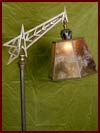
CANOPY:
This is the part of the ceiling fixture that covers the electrical box where the electrical connections are made.
This is the part of the ceiling fixture that covers the electrical box where the electrical connections are made.

I.E.S FLOOR LAMP:
This is a floor lamp with the general structure seen here . They typically consist of a large mogul-base 3-way bulb (100,200, and 300 watt) surrounded by three candles. An advantage of these lamps is that there is a wide range of illumination levels (from one bulb lit at 25 watts to 300 watts lit in the center surrounded by three more bulbs at 25 watts each) and styles (they have been manufactured during all electrical eras). The standard IES BOWL has a 2 7/8″ fitter. The bowl was originally designed as a diffuser, and was intended to support a cloth shade that would cover both the bowl and the three candles (Admittedly, we see plenty used without a shade). Unfortunately, there is no cool torchier-style glass shade that can be used with these lamps.
This is a floor lamp with the general structure seen here . They typically consist of a large mogul-base 3-way bulb (100,200, and 300 watt) surrounded by three candles. An advantage of these lamps is that there is a wide range of illumination levels (from one bulb lit at 25 watts to 300 watts lit in the center surrounded by three more bulbs at 25 watts each) and styles (they have been manufactured during all electrical eras). The standard IES BOWL has a 2 7/8″ fitter. The bowl was originally designed as a diffuser, and was intended to support a cloth shade that would cover both the bowl and the three candles (Admittedly, we see plenty used without a shade). Unfortunately, there is no cool torchier-style glass shade that can be used with these lamps.
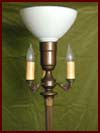
PANS:
Many vintage ceiling fixtures consisted of a pan that served as the central body, from which were hung shade holders (maybe on chains or rods), or arms that in turn supported the shade holders and shade. The pan may have been mounted directly to the ceiling or suspended from chain or rods . Fixtures suspended from very high ceilings may have a cluster between the main body and the canopy where multiple rods or chains are joined, which is then supported by a single rod or chain . A common variation on this theme is the “closed pan”, with 2 to 5 arms, and a top or cover pan, from which the entire assembly was hung, often with chain to the canopy.
Many vintage ceiling fixtures consisted of a pan that served as the central body, from which were hung shade holders (maybe on chains or rods), or arms that in turn supported the shade holders and shade. The pan may have been mounted directly to the ceiling or suspended from chain or rods . Fixtures suspended from very high ceilings may have a cluster between the main body and the canopy where multiple rods or chains are joined, which is then supported by a single rod or chain . A common variation on this theme is the “closed pan”, with 2 to 5 arms, and a top or cover pan, from which the entire assembly was hung, often with chain to the canopy.

PENDANT:
Any ceiling mount fixture that suspends a single glass shade some distance, either by chain or with rod.
Any ceiling mount fixture that suspends a single glass shade some distance, either by chain or with rod.
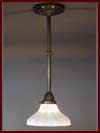
SCONCES:
These are simply any wall-mounted light. It’s a lovely way to add to general room lighting, as well as accenting architectural features of your home.
These are simply any wall-mounted light. It’s a lovely way to add to general room lighting, as well as accenting architectural features of your home.
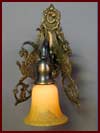
SHADE HOLDER:
The part(s) of a fixture designed to hold the glass shade or globe. Three or four thumbscrews catch the lip of the shade to secure it in place. Common fitter sizes are 2 ¼”, 3 ¼”, 4″ (often a gas style shade that faces up), 6″ (larger globes and schoolhouse shades), and less common sizes are 5″ and 8″. Some pieces screw onto a socket and are typically called a “shade ring” as seen here . Anything 10″ and above are considered bowl holders.
The part(s) of a fixture designed to hold the glass shade or globe. Three or four thumbscrews catch the lip of the shade to secure it in place. Common fitter sizes are 2 ¼”, 3 ¼”, 4″ (often a gas style shade that faces up), 6″ (larger globes and schoolhouse shades), and less common sizes are 5″ and 8″. Some pieces screw onto a socket and are typically called a “shade ring” as seen here . Anything 10″ and above are considered bowl holders.
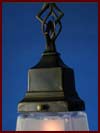
TORCHIER:
These lamps have a single, upward facing glass shade and a three way mogul bulb. They offer good general room illumination, with nice indirect lighting reflected off the ceiling.
These lamps have a single, upward facing glass shade and a three way mogul bulb. They offer good general room illumination, with nice indirect lighting reflected off the ceiling.
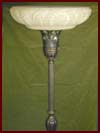
UP TUBING:
This is the vertical section of brass tube that connects the main body of the fixture to the canopy on the ceiling. It cannot be adjusted for length very easily, so measure carefully. For canopies secured here by a set-screw, remember to fully retract the screw and lower it slowly to avoid scratching the finish on the tubing.
This is the vertical section of brass tube that connects the main body of the fixture to the canopy on the ceiling. It cannot be adjusted for length very easily, so measure carefully. For canopies secured here by a set-screw, remember to fully retract the screw and lower it slowly to avoid scratching the finish on the tubing.
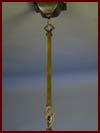
LOOP TO LOOP:
Loops that are connected together as design elements or used for mechanical purposes such as accommodating slant ceilings.
Loops that are connected together as design elements or used for mechanical purposes such as accommodating slant ceilings.
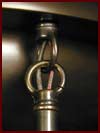
ARMS:
The element that attaches to the body of the fixture and extends out to hold the candle socket or shade holder and glass.
The element that attaches to the body of the fixture and extends out to hold the candle socket or shade holder and glass.

BODY:
The portion of the fixture that acts as the main hub, holding the arms and up tubing or chain. It also functions as the housing for all the wire connections.
The portion of the fixture that acts as the main hub, holding the arms and up tubing or chain. It also functions as the housing for all the wire connections.

CANDLE COVERS:
The decorative sleeve that covers the light socket on a candelabra style sconce, ceiling fixture, or lamp.
The decorative sleeve that covers the light socket on a candelabra style sconce, ceiling fixture, or lamp.
